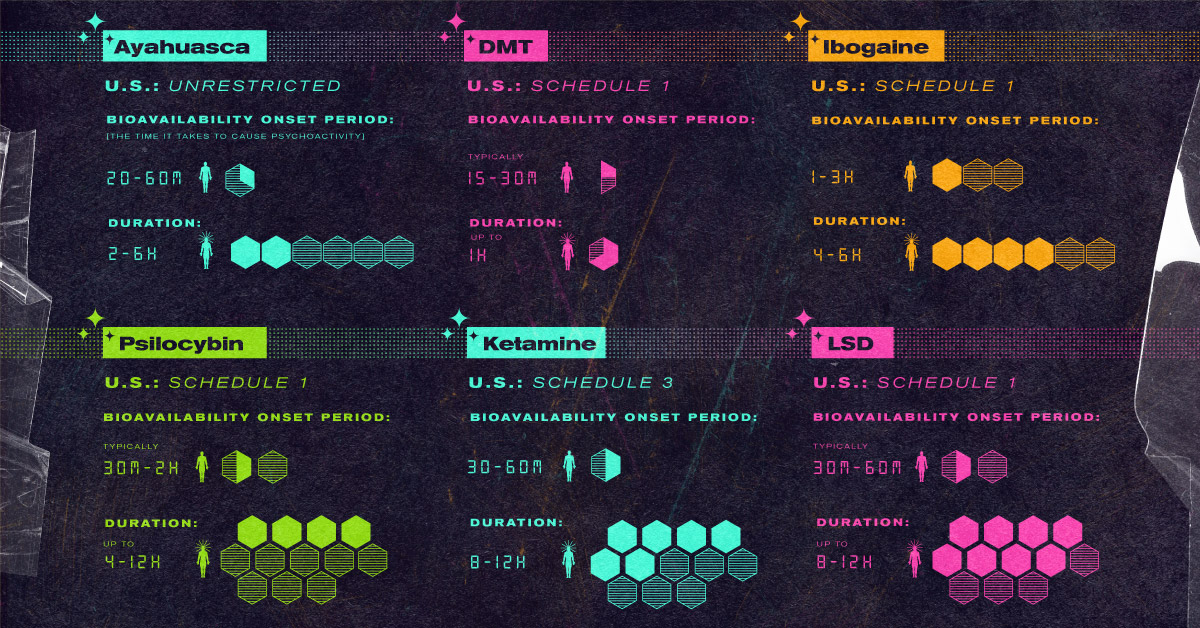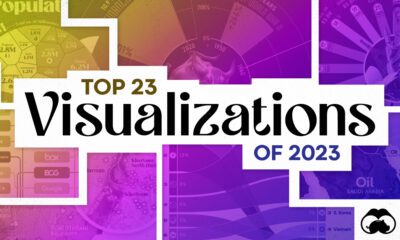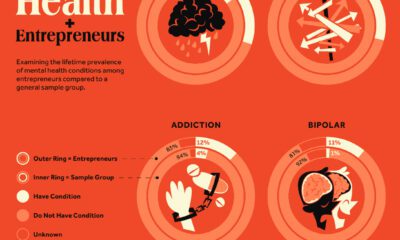Markets
Mind-Bending Medicine: An Overview of Psychedelic Substances

An Overview of Psychedelic Substances
Fueled by a slew of new research, psychedelics may hold the key to treating a multitude of debilitating disorders such as addiction, PTSD, and depression.
But as an industry that has laid dormant for decades, it will need to shed its negative connotations that have limited its potential and undermined new discoveries for so long.
The infographic above showcases data from The Report on Psychedelics which explains seven of the most common psychedelic substances and examines the many mind-bending ways they could radically transform mental health as we know it.
Resurrecting a Stigmatized Industry
Although evidence of humans using psychedelics as medicine dates back thousands of years, it was not until the 1940s that psychiatrists became advocates of their therapeutic potential.
Unfortunately, recreational psychedelics became a symbol of the 1960’s counterculture movement, which contaminated the industry’s reputation. The U.S. responded by introducing the Controlled Substances Analogue Enforcement Act, deeming these drugs illegal and stymying research studies in the process.
Following some new discoveries in the early ‘90s however, psychedelics moved from the hands of festival-goers back to the labs of scientists. Since then, certain substances such as psilocybin have been granted breakthrough therapy status for treating depression by the U.S. FDA.
With these recent developments, new companies and investment opportunities are beginning to emerge in the psychedelics space. But these complex drugs are not always easy to understand—so let’s dive in.
What are Psychedelics?
Psychedelics are psychoactive substances that can alter perception, mood, and cognitive processes. There are two broad classifications of psychedelics that relate to chemical structure.
- Entheogenic Plants: Plants or fungi that produce chemical substances that can cause hallucinations
- Synthetic Drugs: Drugs created in laboratory setting to mimic the effects of entheogenic plants
Here are seven of the most common psychedelic substances explained:
| Drug | Characteristics | Legal Status | Conditions Studied | Number of Studies/trials |
|---|---|---|---|---|
| Ayahuasca (Entheogenic plant) | Traditional tea used in religious or spiritual rituals, mainly in South America. | Not formally prohibited. | Major depression | 1 |
| DMT (Entheogenic plant) | Powerful hallucinogen produced by multiple plants, humans, and animals with an unusually short bioavailability period. | U.S.: Schedule I Canada: Schedule III UN: Schedule I UK: Class A | Healthy subjects | 1 |
| Ibogaine (Entheogenic plant) | Derived from the tabernanthe iboga plant, a shrub found in the rainforest of western Africa. | U.S.: Schedule I Canada: Controlled UN: Uncontrolled UK: Illegal | Drug dependence, alcoholism | 2 |
| Psilocybin (Entheogenic plant) | Naturally occurring psychedelic chemical found in more than 100 species of mushrooms. | U.S: Schedule 1 Canada: Schedule III UN: Schedule I UK: Class A | Depression, OCD, anorexia, migraines, cluster headaches, substance abuse | 40 |
| Ketamine (Synthetic) | Commonly used as an anesthetic and administered intravenously (IV) or intramuscularly (IM). | U.S.: Schedule III Canada: Schedule I UN: Uncontrolled UK: Class B | Depression, mental health disorders, suicidal ideations, pain and related conditions, healthy subjects | 925 |
| LSD (Synthetic) | First derived from ergot, a fungus that develops on grains such as rye. | U.S: Schedule I Canada: Schedule III UN: Schedule I UK: Class A | Cluster headaches, depression, anxiety, chronic pain, Healthy subjects | 12 |
| MDMA (Synthetic) | Typically associated with rave culture, as it imparts feelings of joy combined with increased energy levels. | U.S.: Schedule I Canada: Schedule I UN: Schedule I UK: Class A | PTSD, autism, alcohol use disorder, Healthy subjects | 43 |
To avoid history repeating itself, Johns Hopkins University has created the Center for Psychedelic and Consciousness Research with the aim of enforcing strict standards of scientific rigor for the industry to follow.
On the Precipice of Change
With sound scientific evidence and standards coming into place, it’s no surprise that investors—from bestselling author Tim Ferris to several established cannabis companies—are supporting the born-again industry.
Given the industry’s foothold in recreational use, a therapeutic comeback may be a tough pill for many to swallow. However, it is possible that we are on the precipice of not only a psychedelic revolution but more importantly, a mental health one.
“Psychedelics, used responsibly and with proper caution, would be for psychiatry what the microscope is for biology and medicine or the telescope is for astronomy.”
—Stanislav Grof
Markets
The European Stock Market: Attractive Valuations Offer Opportunities
On average, the European stock market has valuations that are nearly 50% lower than U.S. valuations. But how can you access the market?

European Stock Market: Attractive Valuations Offer Opportunities
Europe is known for some established brands, from L’Oréal to Louis Vuitton. However, the European stock market offers additional opportunities that may be lesser known.
The above infographic, sponsored by STOXX, outlines why investors may want to consider European stocks.
Attractive Valuations
Compared to most North American and Asian markets, European stocks offer lower or comparable valuations.
| Index | Price-to-Earnings Ratio | Price-to-Book Ratio |
|---|---|---|
| EURO STOXX 50 | 14.9 | 2.2 |
| STOXX Europe 600 | 14.4 | 2 |
| U.S. | 25.9 | 4.7 |
| Canada | 16.1 | 1.8 |
| Japan | 15.4 | 1.6 |
| Asia Pacific ex. China | 17.1 | 1.8 |
Data as of February 29, 2024. See graphic for full index names. Ratios based on trailing 12 month financials. The price to earnings ratio excludes companies with negative earnings.
On average, European valuations are nearly 50% lower than U.S. valuations, potentially offering an affordable entry point for investors.
Research also shows that lower price ratios have historically led to higher long-term returns.
Market Movements Not Closely Connected
Over the last decade, the European stock market had low-to-moderate correlation with North American and Asian equities.
The below chart shows correlations from February 2014 to February 2024. A value closer to zero indicates low correlation, while a value of one would indicate that two regions are moving in perfect unison.
| EURO STOXX 50 | STOXX EUROPE 600 | U.S. | Canada | Japan | Asia Pacific ex. China |
|
|---|---|---|---|---|---|---|
| EURO STOXX 50 | 1.00 | 0.97 | 0.55 | 0.67 | 0.24 | 0.43 |
| STOXX EUROPE 600 | 1.00 | 0.56 | 0.71 | 0.28 | 0.48 | |
| U.S. | 1.00 | 0.73 | 0.12 | 0.25 | ||
| Canada | 1.00 | 0.22 | 0.40 | |||
| Japan | 1.00 | 0.88 | ||||
| Asia Pacific ex. China | 1.00 |
Data is based on daily USD returns.
European equities had relatively independent market movements from North American and Asian markets. One contributing factor could be the differing sector weights in each market. For instance, technology makes up a quarter of the U.S. market, but health care and industrials dominate the broader European market.
Ultimately, European equities can enhance portfolio diversification and have the potential to mitigate risk for investors.
Tracking the Market
For investors interested in European equities, STOXX offers a variety of flagship indices:
| Index | Description | Market Cap |
|---|---|---|
| STOXX Europe 600 | Pan-regional, broad market | €10.5T |
| STOXX Developed Europe | Pan-regional, broad-market | €9.9T |
| STOXX Europe 600 ESG-X | Pan-regional, broad market, sustainability focus | €9.7T |
| STOXX Europe 50 | Pan-regional, blue-chip | €5.1T |
| EURO STOXX 50 | Eurozone, blue-chip | €3.5T |
Data is as of February 29, 2024. Market cap is free float, which represents the shares that are readily available for public trading on stock exchanges.
The EURO STOXX 50 tracks the Eurozone’s biggest and most traded companies. It also underlies one of the world’s largest ranges of ETFs and mutual funds. As of November 2023, there were €27.3 billion in ETFs and €23.5B in mutual fund assets under management tracking the index.
“For the past 25 years, the EURO STOXX 50 has served as an accurate, reliable and tradable representation of the Eurozone equity market.”
— Axel Lomholt, General Manager at STOXX
Partnering with STOXX to Track the European Stock Market
Are you interested in European equities? STOXX can be a valuable partner:
- Comprehensive, liquid and investable ecosystem
- European heritage, global reach
- Highly sophisticated customization capabilities
- Open architecture approach to using data
- Close partnerships with clients
- Part of ISS STOXX and Deutsche Börse Group
With a full suite of indices, STOXX can help you benchmark against the European stock market.

Learn how STOXX’s European indices offer liquid and effective market access.

-

 Economy2 days ago
Economy2 days agoEconomic Growth Forecasts for G7 and BRICS Countries in 2024
The IMF has released its economic growth forecasts for 2024. How do the G7 and BRICS countries compare?
-

 Markets2 weeks ago
Markets2 weeks agoU.S. Debt Interest Payments Reach $1 Trillion
U.S. debt interest payments have surged past the $1 trillion dollar mark, amid high interest rates and an ever-expanding debt burden.
-

 United States2 weeks ago
United States2 weeks agoRanked: The Largest U.S. Corporations by Number of Employees
We visualized the top U.S. companies by employees, revealing the massive scale of retailers like Walmart, Target, and Home Depot.
-

 Markets2 weeks ago
Markets2 weeks agoThe Top 10 States by Real GDP Growth in 2023
This graphic shows the states with the highest real GDP growth rate in 2023, largely propelled by the oil and gas boom.
-

 Markets2 weeks ago
Markets2 weeks agoRanked: The World’s Top Flight Routes, by Revenue
In this graphic, we show the highest earning flight routes globally as air travel continued to rebound in 2023.
-

 Markets3 weeks ago
Markets3 weeks agoRanked: The Most Valuable Housing Markets in America
The U.S. residential real estate market is worth a staggering $47.5 trillion. Here are the most valuable housing markets in the country.
-

 Debt1 week ago
Debt1 week agoHow Debt-to-GDP Ratios Have Changed Since 2000
-

 Markets2 weeks ago
Markets2 weeks agoRanked: The World’s Top Flight Routes, by Revenue
-

 Countries2 weeks ago
Countries2 weeks agoPopulation Projections: The World’s 6 Largest Countries in 2075
-

 Markets2 weeks ago
Markets2 weeks agoThe Top 10 States by Real GDP Growth in 2023
-

 Demographics2 weeks ago
Demographics2 weeks agoThe Smallest Gender Wage Gaps in OECD Countries
-

 United States2 weeks ago
United States2 weeks agoWhere U.S. Inflation Hit the Hardest in March 2024
-

 Green2 weeks ago
Green2 weeks agoTop Countries By Forest Growth Since 2001
-

 United States2 weeks ago
United States2 weeks agoRanked: The Largest U.S. Corporations by Number of Employees
















